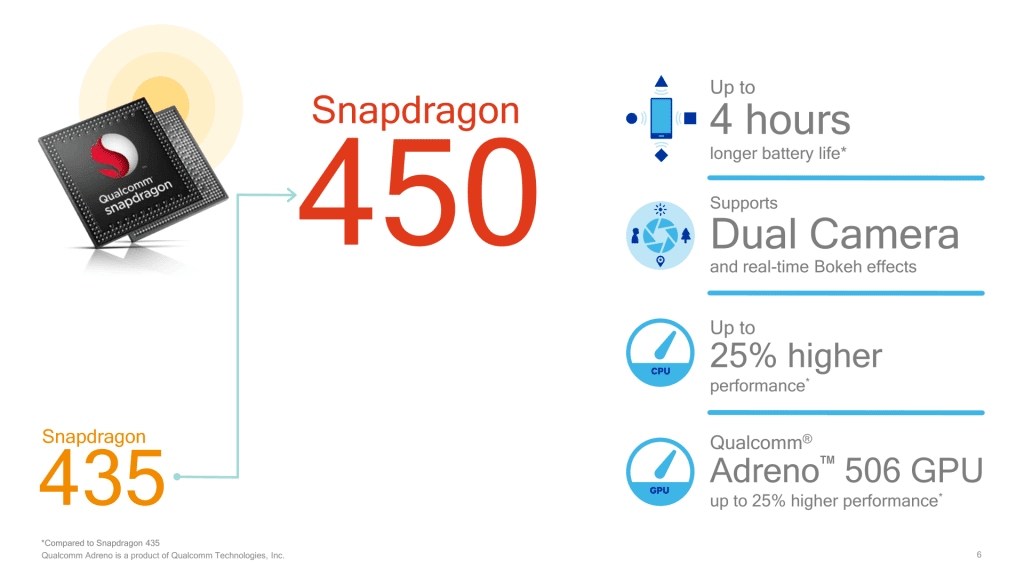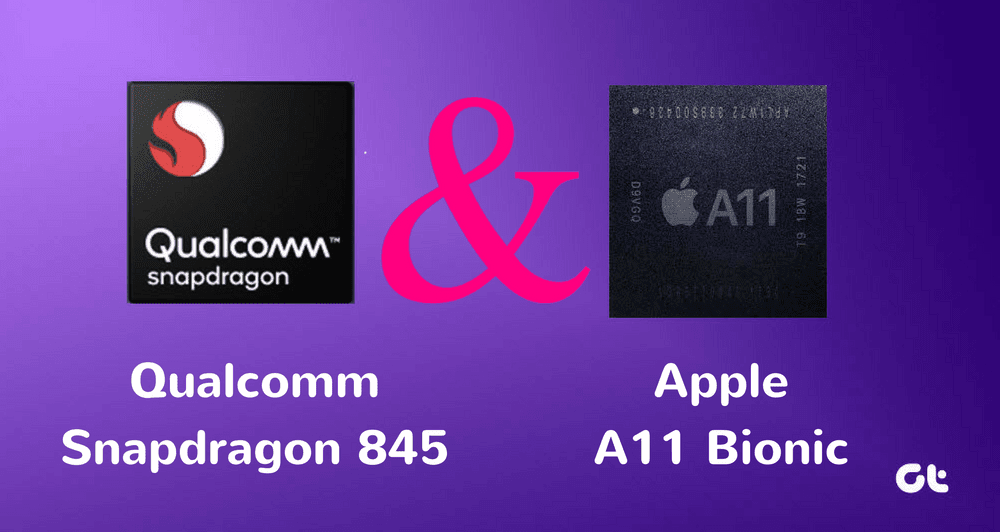At first glance, the Snapdragon 625, 626 and 630 don’t seem to be much different from one another. To be precise, this holds (almost) true for the first two chips. The newest Snapdragon 630, on the other hand, does boast some significant upgrades. So, let’s dive into the individual specs of the three SoCs first.
Snapdragon 625 Specifications
Manufacturing Process: 14 nanometreArchitecture: 64-bitCPU: 8 x ARM Cortex-A53 Up to 2.0 GHzGPU: Adreno 506 Up to 650 MHzCellular Modem: X9 LTE (Download: 300 Mbps, Upload: 150 Mbps)Display Support: Up to 1920 x 1200 @ 60 fpsCamera: Dual ISP (Image Signal Processor), Up to 24 MPVideo Capture and Playback: Up to 4K Ultra HD @ 30 fpsDSP (Digital Signal Processor): Qualcomm Hexagon 546Wi-Fi:11a/b/g/n/ac (2.4 GHz + 5 GHz) Up to 433 MbpsBluetooth: 4.1, BLE (Bluetooth Low Energy)RAM: LPDDR3 933 MHzStorage: SD 3.0 and eMMC 5.1USB: 3.0Charging: Qualcomm Quick Charge 3.0
Snapdragon 626 Specifications
Manufacturing Process: 14 nanometreArchitecture: 64-bitCPU: 8 x ARM Cortex-A53 Up to 2.2 GHzGPU: Adreno 506 Up to 650 MHzCellular Modem: X9 LTE (Download: 300 Mbps, Upload: 150 Mbps)Display Support: Up to 1920 x 1200 @ 60 fpsCamera: Dual ISP (Image Signal Processor), Up to 24 MPVideo Capture and Playback: Up to 4K Ultra HD @ 30 fpsDSP (Digital Signal Processor): Qualcomm Hexagon 546Wi-Fi:11a/b/g/n/ac (2.4 GHz + 5 GHz) Up to 433 MbpsBluetooth: 4.2, BLE (Bluetooth Low Energy)RAM: LPDDR3 933 MHzStorage: SD 3.0 and eMMC 5.1USB: 3.0Charging: Qualcomm Quick Charge 3.0
Snapdragon 630 Specifications
Manufacturing Process: 14 nanometreArchitecture: 64-bitCPU: 4 x ARM Cortex-A53 Up to 2.2 GHz + 4 x Cortex-A53 Up to 1.8 GHzGPU: Adreno 508 Up to 850 MHzCellular Modem: X12 LTE (Download: 600 Mbps, Upload: 150 Mbps)Display Support: Up to QXGA (2048 x 1536) @ 60 fpsCamera: Dual ISP + Qualcomm Spectra 160 ISP, Up to 24 MPVideo Capture and Playback: Up to 4K Ultra HD @ 30 fps, 1080p @ 120 fpsDSP (Digital Signal Processor): Qualcomm Hexagon 642Wi-Fi:11a/b/g/n/ac (2.4 GHz + 5 GHz) Up to 433 MbpsBluetooth: 5.0RAM: Dual Channel LPDDR4 1333 MHzStorage: SD 3.0, eMMC 5.1 and UFSUSB: 3.1Charging: Qualcomm Quick Charge 4
Going by the specs, you can clearly see how similar the Snapdragon 625 and 626 are. Still, for the sake of comparison, let’s pit the trio against each other individually.
Snapdragon 625 Vs Snapdragon 626
The Snapdragon 626 is the successor of the Snapdragon 625. Even though Qualcomm launched the newer chip after an interval of eight months, it doesn’t bring any notable improvements over its precursor. Frankly, the 626 is just an overclocked version of the 625. This makes the former around 10 percent more powerful than the latter. Apart from this, the only thing that Qualcomm has changed is the Bluetooth version. The Snapdragon 626 supports Bluetooth v4.2, while its predecessor is locked out at Bluetooth v4.1. And this concludes the difference between them.
Snapdragon 626 Vs Snapdragon 630
Superficially, the Snapdragon 630 and 626 appear quite identical to each other. But, dig a little deeper, and you will find some significant upgrades in the newer 630. Only in terms of processing power, the 626 has a minute advantage.
Performance
This is due to the fact that all eight cores of it are clocked at 2.2 GHz, whereas, in Snapdragon 630 only four of them run at 2.2 GHz while the rest max out at 1.8 GHz. However, it is extremely unlikely that you’ll notice this difference in day to day usage. In fact, due to this low powered cores, the Snapdragon 630 returns slightly better battery life. When it comes to graphics, the Adreno 508 GPU of the Snapdragon 630 offers 30 percent better performance than the Adreno 506 of the 626. This newer graphics processor is clocked at 850 MHz compared to 650 MHz of its predecessor. The Snapdragon 630 supports dual channel LPDDR4x RAM with up to 1333 MHz clock speed. In comparison, the Snapdragon 626 can accommodate single channel LPDDR3 RAM running at up to 933 MHz. This drastically improves the app launching time and memory management in the latest chipset.
Camera
For the first time, Qualcomm has included its Spectra 160 ISP (Image Signal Processor) in a non-flagship chipset. Yes, the Snapdragon 630 features same ISP present in the high-end Snapdragon 820 and 821 SoCs. This is a significant improvement over the normal dual ISP of the 626. Moreover, the successor of the Snapdragon 626 comes with an upgraded Hexagon 642 DSP (Digital Signal Processor). This brings neural processing capability and ‘All-Ways-Aware’ to the Snapdragon 630 along with better multimedia performance, sensor integration, and camera processing.
Maximum Display Resolution
The Snapdragon 630 supports up to QXGA (2048 x 1536) onscreen resolution at 60fps, while the 626 maxes out at QUXGA (1920 x 1200) at 60 fps. Qualcomm achieved this mainly due to the superior GPU of the newer chip.
Storage and I/O
Storage is another undercover improvement present in the Snapdragon 630. The new SoC supports the latest UFS memory modules, whereas, the Snapdragon 626 can’t go beyond SD 3.0 and eMMC 5.1. This means faster app installation and smoother system response. Qualcomm has beefed up the I/O (Input/output) of its newer chip. The Snapdragon 630 supports USB 3.1 while its predecessor is restricted to USB 3.0. Theoretically, this means, that the latest SoC can facilitate up to 10 Gbps transfer (or copy) speed, in comparison to 5 Gbps of the older one.
Connectivity
Lastly, the Snapdragon 630 packs the X12 LTE modem, which means it can support up to 600 Mbps 4G download speed and 150 Mbps upload speed. In comparison, the X9 LTE modem of the 626 can facilitate up to 300 Mbps download speed and the same upload speed.
Charging Speed
The recent SoC supports Qualcomm Quick Charge 4, while the older Snapdragon 626 is equipped with Quick Charge 3.0. This means that you will get faster charging speed with the 630. Qualcomm claims a battery life of 5 hours with just 5 minutes of charging a 2750mAh cell on the newer SoC.
Snapdragon 625 vs Snapdragon 630
There is practically nothing new to write here. Just note that the CPU advantage that Snapdragon 626 had over the 630 is not there with the 625. The rest of the differences are already mentioned above.
Wrapping It Up
Qualcomm has packed several features of its last year’s flagship into the Snapdragon 630. The best part is that the latest chip does have some significant upgrades which are non-existent between the Snapdragon 626 and 625. But if you own a smartphone with 625 or 626, it doesn’t make sense to shift to a Snapdragon 630 device. If you want something extra, go for the Snapdragon 660 or the Snapdragon 820 / 821. For new buyers, 630 is an excellent chip. Phones like the Xiaomi Redmi Note 5 and Moto X4 might come equipped with it. The above article may contain affiliate links which help support Guiding Tech. However, it does not affect our editorial integrity. The content remains unbiased and authentic.










